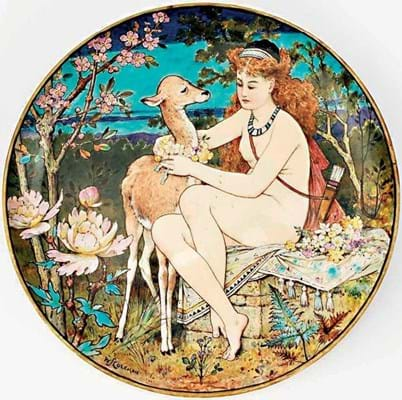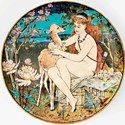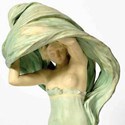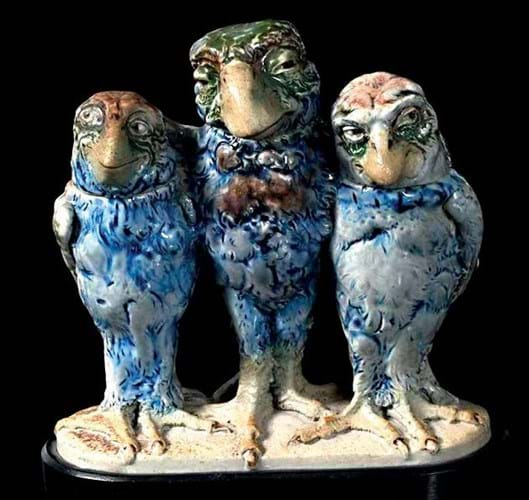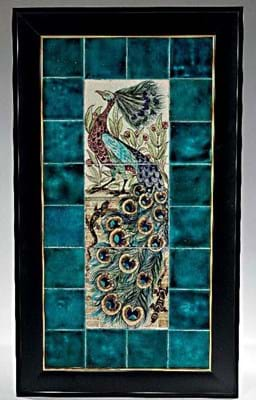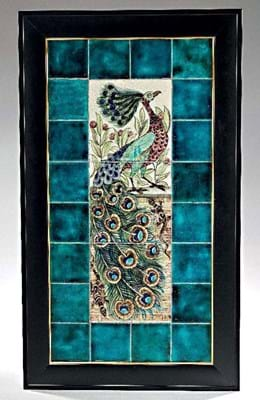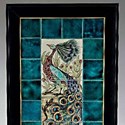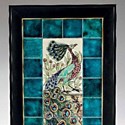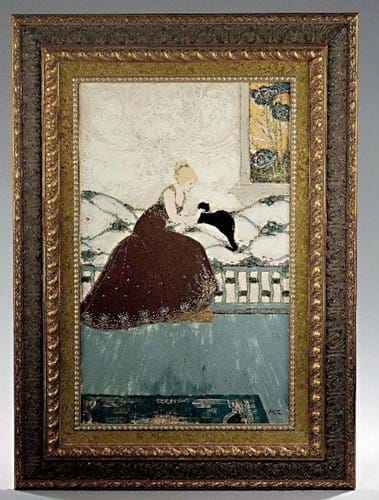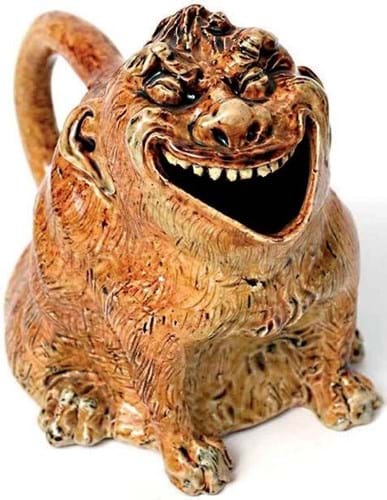
The Martinware spoon warmer that led Woolley & Wallis’ two-day sale of British Art Pottery and Design when it sold for £50,000.
Ceramics have always played a major role in the field of late 19th and early 20th century decorative arts as many artists and designers turned their hand to this medium, experimenting with different glazes and forms or creating designs for ceramic production.
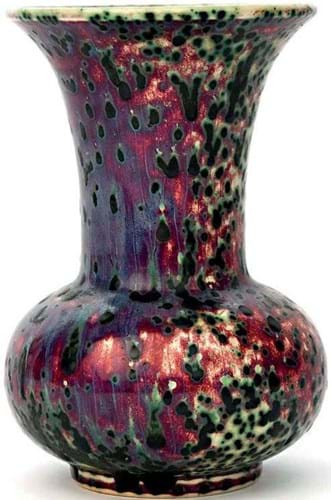
Another of the single-owner collections in Woolley & Wallis’ sale was a 26-lot consignment composed predominantly of the ceramicist William Howson Taylor’s Ruskin Pottery. This comprised the private collection of Gretchen Andersen of The Lacquer Chest antiques shop in Kensington Church Street who had purchased the collection as a whole back in the 1980s. Offered here fresh to the market with attractive estimates, it all found buyers. The most expensive piece of Andersen’s Ruskin ware was one of Howson Taylor’s high-fired stoneware vases. This 6in (15.5cm) high specimen covered in a sang de boeuf glaze over white, with lavender and mint green speckles, has an impressed mark and is dated 1907. It sold for £1500.
Two auctions held recently – one in Salisbury on November 29-30 and the other in London on December 5 – emphasised this dominance as their titles made clear.
Both Woolley & Wallis’ British Art Pottery and Design sale and Bonham’s 20th century Decorative Arts and Ceramics auction featured some other categories of decorative arts but ceramics made up the lion’s share of the content and provided a good cross-section of material in this field for potential buyers.
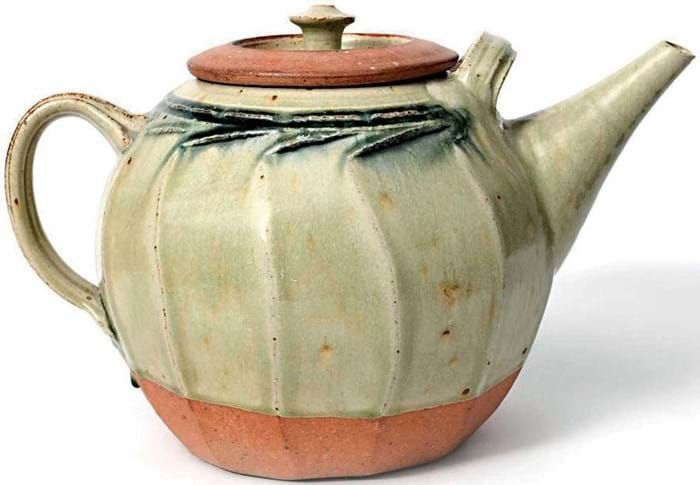
Much of the second day of Woolley & Wallis’ sale was given over the studio pottery with a large range in terms of makers, dates and prices. Opening this session were around 50 lots by Richard Batterham (1936-2021) whose estate the auction firm is dispersing in a series of instalments. Conservatively estimated, this attracted worldwide attention largely from private collectors. Most of the pieces sold for three-figure sums but among the handful making four-figure prices was this large 10in (25cm) cut-sided twin handled stoneware teapot covered in an ash glaze which realised £2800, a multiple of the £200-400 guide.
Solid choice
The Woolley & Wallis (26/20% buyer’s premium) auction contained a wide range of ceramics from many of the best-known producers of art pottery as well as a selection of more recent studio pottery.
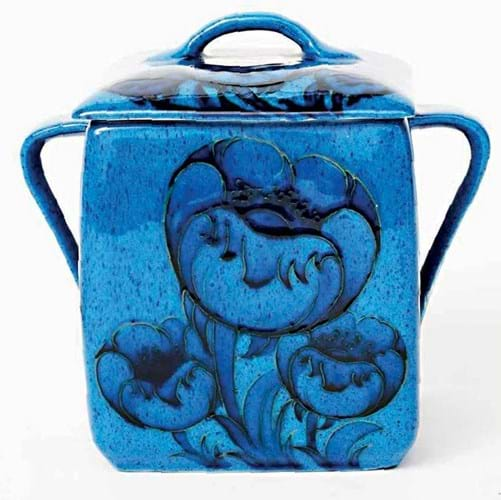
A Moorcroft pottery section in Woolley & Wallis’ sale mostly performed as predicted with one notable exception. Two private collectors went head to head to secure this 6½in (16.5cm) high distinctive square section biscuit box designed by William Moorcroft in the blue tubelined Big Poppy pattern. As a result the £400-600 estimate was left trailing and the hammer finally fell at £3500.
Specialist Michael Jeffrey characterised it as “solid, with nice collections dotted through the sale”, offering plenty of price choice including entry level pieces. When it came to the upper price echelons, though, it was Martinware that dominated. The auction firm had a sizable amount to offer, almost 60 lots in total: over 30 from various owners and another 23 consigned from the personal collection of the dealer Barry Stock.

Maw & Co’s lustred pottery does not have the same name recognition as the equivalent items from William De Morgan’s stable but this example proved to be in great demand at the Woolley & Wallis sale, making £1600, around three times the estimate. The 13in (34cm) diameter charger painted in ruby on white with a highly decorative design of an equestrian figure of a knight was one of the lots consigned from the collection of Barry Stock. It is monogrammed MJ, an artist who has produced other pieces for the firm but whose identity is as yet unknown.
While the Martin Brothers’ Wally Birds – their avian tobacco jars with detachable heads modelled as Victorian characters – have been the most sought after of their products and the big money-spinners for decades now, more recently collectors have turned their attention to other classes of Martinware.
Most notably there is increasing focus on the brothers’ grotesques, often modelled as spoon warmers. These pieces designed as creatures with wide gaping mouths have all the quirkiness and humour associated with Martinware (sometimes with a slightly medieval gargoyle-like resemblance).
Back in 2012, for example, Woolley & Wallis hammered down a seated grotesque for £50,000 and in 2018 a massive model of a grinning crab realised $220,000 (£184,000) at Phillips in New York.
More recently in November 2022 a hoof-footed creature with a curly pig’s tail and gurning expression was bid to £24,000 in a sale at Hyperion Auctions in Cambridgeshire.
In this latest Salisbury auction it was another spoon warmer that made the top price (pictured top). A particularly fine example dated 1880, it was modelled with a grinning face open wide to reveal a fine upper row of teeth and with a tail curled round to form the handle. It measured 6in (15.5cm) and was incised R W Martin 9.80 London & Southall and impressed with an RW Martin mark.
Estimated to take £15,000-25,000, it generated a huge amount of international and UK competition and ended up selling for £50,000.
A second smaller 4in (10.5cm) high spoon warmer dating from a year earlier incised R W Martin London & Southall 11-79, and number 15 was modelled as a grinning reptile, its body incised and glazed to resemble scales. This got away for less than the £15,000-20,000 guide at £12,000, probably held back by some condition issues.
Avian models from the brothers included double and triple bird groups by Robert Wallace Martin.
The 7in (18cm) high triple group, which was last under the hammer at Christie’s New York in 1994, was modelled with a central bird with outstretched wings around its flanking companions and glazed predominantly in blue and buff. It was incised R W Martin & Bros, London & Southall, and had a base dated 1905 and two heads dated 1908. This realised £30,000 against a £30,000-40,000 guide.
The 5¾in (14.5cm) high double bird group incised RW Martin & Bros, Southall and glazed in blue, green and aubergine was part of the Martinware that had been consigned from Barry Stock and had an estimate of £16,000-20,000. It had been up for sale much more recently at Rago Auctions in 2019 but here it failed to get away.

This finely worked Martinware jug decorated in low relief with a goat mask was taken to £9500 in the Woolley & Wallis sale.
There was plenty of interest, however, for a dated piece by two of the other brothers, Edwin and Walter Martin: an 11in (26.5cm) high stoneware jug finely modelled with a low relief goat mask and incised 1-1896 Martin Bros, London & Southall.
This ended up making £9500 against predictions of £3000-5000.
American collection

William De Morgan parrot plaque, £11,000 at Bonhams.
A feature of Bonhams’ (28/27/21/14.5% buyer’s premium) sale on December 5 was the opening 79 lots from the collection of David and Helen Milling, an American couple with an enthusiasm for Art Nouveau and Arts & Crafts pieces by makers on both sides of the Atlantic. Bonhams was selling around 250 items from their collection across its US and UK rooms.
The Millings, who both had backgrounds in arts and architecture, were interested in colourful English Art Nouveau tiles and American iridescent glass shades from a young age. Following their marriage their collecting pursuits deepened to includes a broader range of Art & Crafts tiles and other ceramics by influential figures such as William De Morgan, Walter Crane and Edward Burne Jones.
Although Martinware was a big focus in the Salisbury auction, here the spotlight fell on another Victorian London pottery: William De Morgan of Sands End, Fulham. Almost half the 79 Milling lots offered in the Knightsbridge rooms were given over to De Morgan’s brightly coloured and exotically glazed and patterned tiles and vessels.
Most pieces in the consignment got away and there were some strong individual prices.
These included three impressive tile panels from c.1890 in De Morgan’s colourful and exotic Oriental-inspired style: two with a peacock and one with a parrot design, all of which had been acquired from the specialist Kensington Church Street art pottery dealer Richard Dennis.
The peacock panels, which measured 2ft x 12in (61 x 30cm) and were guided at £10,000-15,000 apiece, were each composed of three 6in tiles painted with the long-tailed bird perched on a wall framed by three inch turquoise tiles. They sold for £25,000 and £30,000.
The smaller parrot design comprised two 8in tiles, each decorated with a bird turning back to look at its companion, again in a turquoise tile surround. This measured 11 x 18½in (27 x 47cm) and was impressed with a De Morgan rose mark and Wm De Morgan-Sands End Pottery-Fulham. Estimated at £3000-5000, it sold for £11,000.
Notable results for De Morgan vases in the Milling consignment included two pieces decorated by Joe Juster, both acquired from the London decorative arts dealership Haslem and Whiteway in the 1990s.
One was an 11in (28cm) twin-handled vase from c.1890, decorated in Persian-inspired style in predominantly blue green and turquoise glazes with swimming fish on a swirling sea background, that sold for £8500. It had the impressed Sand’s End pottery mark and artist’s initials.
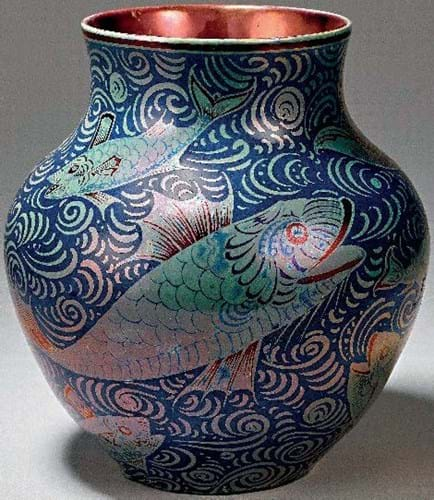
William De Morgan lustre decorated Sunset and Moonlight vase painted by Joe Juster, £6500 at Bonhams.
The other, 9in (21cm) high, from 1895 bearing the painted mark D.M. FULHAM/2263/J.J.8. had a similar design known as ‘Sunset and Moonlight’ but with a triple lustre glaze and made £6500.

The most expensive of a group of Pilkingtons Royal Lancastrian wares in the Milling collection at Bonhams was this vase by Gordon Forsyth decorated with lustre panels of fish which made £12,000 at Woolley & Wallis.
The other notable feature of the Milling property was a 13-lot section of Pilkington’s Royal Lancastrian vases and chargers lustre decorated with designs mostly by the artists Gordon Forsyth, Walter Crane and Richard Joyce.
Topping the list here at £12,000, a multiple of the £2000-3000 estimate, was an 11in (26.5cm) high vase from 1909 by Forsyth hand painted with leaping fish in alternating red and gold lustre bearing factory marks, the artist’s painted seal and a standing antelope date cypher for 1909.
Also making more than its £2000-3000 guide at £10,000 was a 21 x 12½in (54 x 32cm) painted and tube-lined ceramic panel painted, slip decorated, etched, gilded and signed by Léon Victor Solon with The Black Cat, a scene of an elegant lady accompanied by a feline seated in her boudoir.
It bore labels to the back for a March 1999 Christie’s sale of Decorative Arts and for The Fine Art Society London, August 1984.
This panel is illustrated and reviewed in the October 1899 edition of The Studio where the review comments on the artist and this particular piece that “…it is clear to all who are acquainted with his work and methods that the practice of the craft has been carried in his hands to a high pitch of advancement…. And this dexterity of drawing is conjoined with a thorough knowledge and mastery of the potter’s technical processes.”
Best sellers
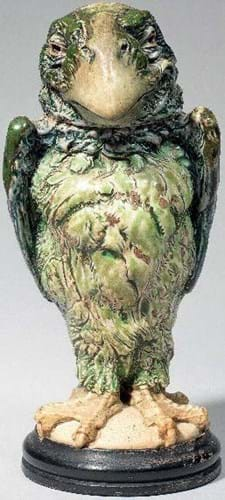
Two Martinware Wally birds featured in Bonhams’ December 5 auction. The more expensive of these at £20,000 was this 10in (25cm) high Robert Wallace Martin jar and cover incised and painted R.W.Martin & Bros./31.1.1907/London & Southall to the foot and collar
Outside the Milling property, top prices came for a Martinware Wally bird, a 10in (25cm) Robert Wallace Martin jar and cover incised and painted R.W.Martin & Bros./31.1.1907/ London & Southall, to the foot and collar, that made £20,000; and a signed stoneware Fish sculpture from c.1930 by the Parisian-based sculptor Séraphine Nikolaevich Soudbinine which made £18,000.
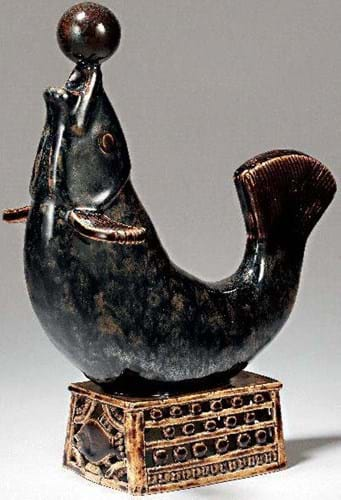
Séraphin Nikolaevich Soudbinine (1870-1944) started out as an actor in Moscow, moved to Paris to work as a sculptor as a pupil of Auguste Rodin and was a self-taught ceramicist. A couple of his ceramic creations were included in Bonhams’ sale, one of which was this 12in (30cm) high model of a fish balancing a ball on its mouth set on an openwork base and covered in a dark mottled glaze with a slight lustre. Dated to c.1930, signed Soudbinine and with a painted artist’s mark SERA/ PHIN, it sold for £18,000, comfortably over the estimate of £5000-7000.
From the non-ceramic pieces, an Arts & Crafts cabinet from c.1877-82 designed by the architect Richard Norman Shaw sold at £20,000.
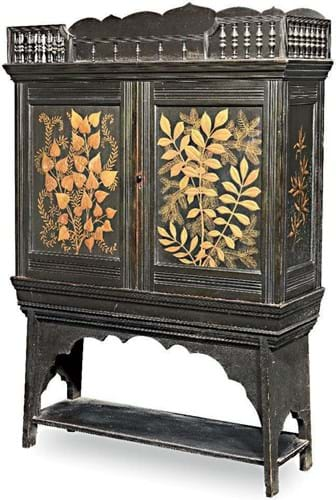
Outside the ceramics offerings in Bonhams’ sale the highest price at £20,000 was paid for this 6ft x4ft (1.8 x 1.23m) Arts & Crafts cabinet from c.1877-82. It was designed by the architect Richard Norman Shaw (1831-1912) and executed by WH Lascelles with raised gilt gesso decoration by J Aldam Heaton.


